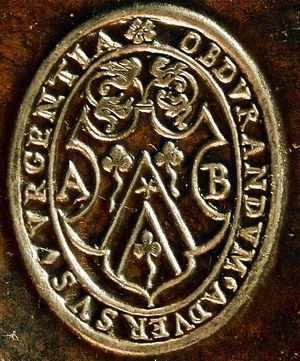Difference between revisions of "Adam Bothwell ca.1529-1593"
| Line 12: | Line 12: | ||
====Characteristic Markings==== | ====Characteristic Markings==== | ||
Bothwell often marked his folio volumes with an armorial stamp, bearing the motto Obdurandum adversus urgentia (‘stand firm against pressure’). He also inscribed his books with various versions of his episcopal signature ‘Adamus episcopus orchaden[sis]’, or with his personal signature ‘ABoithuel’ or ‘Adamus Boithuel’. It is very possible that many of his books might not have been personalised at all. | Bothwell often marked his folio volumes with an armorial stamp, bearing the motto Obdurandum adversus urgentia (‘stand firm against pressure’). He also inscribed his books with various versions of his episcopal signature ‘Adamus episcopus orchaden[sis]’, or with his personal signature ‘ABoithuel’ or ‘Adamus Boithuel’. It is very possible that many of his books might not have been personalised at all. | ||
| − | [[file: Adam_Bothwell.jpg|thumb| | + | [[file: Adam_Bothwell.jpg|thumb|500px| Inscription of Bishop Adam Bothwell (NLS RB.l.18)]] |
====Sources==== | ====Sources==== | ||
Latest revision as of 00:19, 8 January 2025
Adam BOTHWELL, Bishop of Orkney, ca.1529-1593
Biographical Note
Son of Francis Bothwell of Edinburgh, a Lord of Session (d. 1535), and his second wife, Katherine Bellenden. He came from a well-connected Edinburgh family with links to local politics and the King’s government. Not much is known of his early life, though it is possible he studied at the University of Orléans. Bothwell’s first post in the Church was as parson of Ashkirk, a prebend of Glasgow Cathedral (1552), and he later became vicar of Corstorphine near Edinburgh, where he had inherited property. In 1555 he went on government business to Orkney, and in 1559 was nominated Bishop of Orkney. However, he quickly joined the reformers after the overthrow of the Catholic Church, and during the 1560s was on several committees, including one revising the Book of Discipline. In 1564 he was appointed an extraordinary Lord of Session, and became an ordinary Lord the next year. He was appointed to the Privy Council probably at the same time. At some unknown date he married Margaret Murray (d. 1608), daughter of John Murray of Touchadam, with whom he had six sons and two daughters. He conducted the marriage of Mary Queen of Scots to the Earl of Bothwell on 15 May 1567 and on 29 July of the same year officiated at the coronation ceremony of the infant James VI, immediately following Mary’s abdication. Although he called himself, and was known as, Bishop of Orkney until his death, he is not known to have visited his see after 1567, and the following year exchanged his episcopal temporalities for the lands of the former Holyrood Abbey in Edinburgh, becoming the Abbey’s commendator. Thereafter he occupied himself in his legal duties, attended parliament as a Privy Councillor, and acted as a government administrator.
Books
Bothwell was one of the major book owners of sixteenth-century Scotland. Over the course of his life he assembled a wide-ranging humanist library, covering many subjects, such as theology and biblical studies (comprising, for someone who started his career as a cleric, a surprisingly modest proportion of the whole, at less than a third of the total known titles), law, language and literature, medicine, philosophy and history. The titles were listed in a post-mortem inventory in 1594 (transcribed and published in 1932), but this has not survived in its entirety: it lists just over 500 items, but it is possible that Bothwell’s library at his death exceeded 700 volumes. Only thirty-five surviving Bothwell volumes, containing thirty-nine works, have currently been identified, scattered world-wide, but with Edinburgh University Library and the National Library of Scotland having the strongest holdings.
Some examples of currently extant copies which belonged to Bothwell are: Theodor Zwinger’s encyclopedia Theatrum vitae humanae, printed by Froben in Basel in 1571 (St Andrews University TypSwB.B71FZ) and subsequently owned by William Annand; a polyglot Old Testament (Hebrew, Greek and Latin), printed in Heidelberg in 1587 (New College Library, Edinburgh University X5/a1) also owned later by Annand; Johannes Carion’s popular history textbook Chronicon Carionis (Wittenberg, 1580) (Edinburgh University RB.F.587); the works of St Jerome printed at the Froben press, 1537 (1536-1538), and later owned by Thomas Sydserff (NLS RB.l.18); Commentarius verborum iuris (Basel, 1558), a reference work on law by the French Calvinist jurist Francois Hotman (Napier University, Edward Clark Collection B 147).
Characteristic Markings
Bothwell often marked his folio volumes with an armorial stamp, bearing the motto Obdurandum adversus urgentia (‘stand firm against pressure’). He also inscribed his books with various versions of his episcopal signature ‘Adamus episcopus orchaden[sis]’, or with his personal signature ‘ABoithuel’ or ‘Adamus Boithuel’. It is very possible that many of his books might not have been personalised at all.
Sources
- British Armorial Bindings
- 'The Cataloge of Adame Bischope of Orknayis buiks 1594’, in The Warrender Papers Volume II, edited by Annie I. Cameron, Publications of the Scottish History Society, Third Series, Vol. 19 (Edinburgh: Scottish History Society, 1932), pp. 396-413, 461-465.
- Durkan, J. & Ross, A. Early Scottish Libraries, Glasgow, John S. Burns, 1961
- Shaw, Duncan. ‘Adam Bothwell, a conserver of the Renaissance in Scotland’ in I. B. Cowan and D. Shaw (eds). The Renaissance and Reformation in Scotland: essays in honour of Gordon Donaldson, Scottish Academic Press, 1983
Shaw, Duncan. "Bothwell, Adam (1529?–1593), bishop of Orkney." Oxford Dictionary of National Biography

